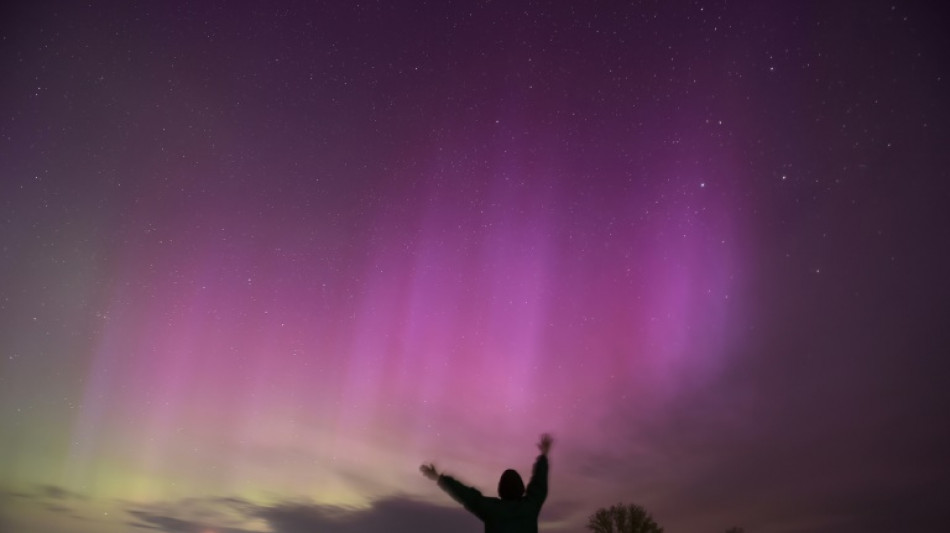
-
 Tokyo stocks hit new record as markets extend global rally
Tokyo stocks hit new record as markets extend global rally
-
Japan's Takaichi eyes expanding coalition, reports say

-
 Canadian PM to visit White House to talk tariffs
Canadian PM to visit White House to talk tariffs
-
Indonesia school collapse toll hits 67 as search ends

-
 Dodgers hold off Phillies, Brewers on the brink
Dodgers hold off Phillies, Brewers on the brink
-
Lawrence sparks Jaguars over Chiefs in NFL thriller

-
 EU channels Trump with tariffs to shield steel sector
EU channels Trump with tariffs to shield steel sector
-
Labuschagne out as Renshaw returns to Australia squad for India ODIs

-
 Open AI's Fidji Simo says AI investment frenzy 'new normal,' not bubble
Open AI's Fidji Simo says AI investment frenzy 'new normal,' not bubble
-
Tokyo stocks hit new record as Asian markets extend global rally

-
 Computer advances and 'invisibility cloak' vie for physics Nobel
Computer advances and 'invisibility cloak' vie for physics Nobel
-
Nobel literature buzz tips Swiss postmodernist, Australians for prize

-
 Dodgers hold off Phillies to win MLB playoff thriller
Dodgers hold off Phillies to win MLB playoff thriller
-
China exiles in Thailand lose hope, fearing Beijing's long reach

-
 Israel marks October 7 anniversary as talks held to end Gaza war
Israel marks October 7 anniversary as talks held to end Gaza war
-
Indians lead drop in US university visas

-
 Colombia's armed groups 'expanding,' warns watchdog
Colombia's armed groups 'expanding,' warns watchdog
-
Shhhh! California bans noisy TV commercials

-
 Trump 'happy' to work with Democrats on health care, if shutdown ends
Trump 'happy' to work with Democrats on health care, if shutdown ends
-
Trump says may invoke Insurrection Act to deploy more troops in US

-
 UNESCO board backs Egyptian for chief after US row
UNESCO board backs Egyptian for chief after US row
-
Unreachable Nobel winner hiking 'off the grid'

-
 Retirement or marketing gimmick? Cryptic LeBron video sets Internet buzzing
Retirement or marketing gimmick? Cryptic LeBron video sets Internet buzzing
-
CAF 'absolutely confident' AFCON will go ahead in protest-hit Morocco

-
 Paris stocks slide amid French political upheaval, Tokyo soars
Paris stocks slide amid French political upheaval, Tokyo soars
-
EU should scrap ban on new combustion-engine sales: Merz

-
 US government shutdown enters second week, no end in sight
US government shutdown enters second week, no end in sight
-
World MotoGP champion Marquez to miss two races with fracture

-
 Matthieu Blazy reaches for the stars in Chanel debut
Matthieu Blazy reaches for the stars in Chanel debut
-
Macron gives outgoing French PM final chance to salvage government

-
 Illinois sues to block National Guard deployment in Chicago
Illinois sues to block National Guard deployment in Chicago
-
Exiled Willis succeeds Dupont as Top 14 player of the season

-
 Hamas and Israel open talks in Egypt under Trump's Gaza peace plan
Hamas and Israel open talks in Egypt under Trump's Gaza peace plan
-
Mbappe undergoing treatment for 'small niggle' at France camp: Deschamps

-
 Common inhalers carry heavy climate cost, study finds
Common inhalers carry heavy climate cost, study finds
-
Madagascar president taps general for PM in bid to defuse protests

-
 UEFA 'reluctantly' approves European league games in US, Australia
UEFA 'reluctantly' approves European league games in US, Australia
-
Hundreds protest in Madagascar as president to announce new premier

-
 Greta Thunberg lands in Greece among Gaza flotilla activists deported from Israel
Greta Thunberg lands in Greece among Gaza flotilla activists deported from Israel
-
UNESCO board backs Egyptian ex-minister for top job: official

-
 Facing confidence vote, EU chief calls for unity
Facing confidence vote, EU chief calls for unity
-
Cash-strapped UNHCR shed 5,000 jobs this year

-
 Mbappe to have 'small niggle' examined at France camp: Deschamps
Mbappe to have 'small niggle' examined at France camp: Deschamps
-
Brazil's Lula asks Trump to remove tariffs in 'friendly' phone call

-
 'Terrible' Zverev dumped out of Shanghai by France's Rinderknech
'Terrible' Zverev dumped out of Shanghai by France's Rinderknech
-
What are regulatory T-cells? Nobel-winning science explained

-
 OpenAI signs multi-billion dollar chip deal with AMD
OpenAI signs multi-billion dollar chip deal with AMD
-
Salah under fire as Liverpool star loses his spark

-
 Paris stocks drop as French PM resigns, Tokyo soars
Paris stocks drop as French PM resigns, Tokyo soars
-
ICC finds Sudan militia chief guilty of crimes against humanity


Third time could prove lucky for aurora viewers around the world
Anyone who missed the dazzling auroras dancing across night skies earlier this weekend will get another chance Sunday evening, as the powerful geomagnetic storm hitting the Earth is expected to intensify yet again.
"Several intense Coronal Mass Ejections are still anticipated to reach the Earth's outer atmosphere by later today," the US National Weather Service said.
Those ejections -- expulsions of plasma and magnetic fields from the Sun, known as CMEs -- have since Friday produced spectacular celestial shows across swaths of the Earth, far from the extreme latitudes where the auroras are normally seen.
But while many viewers have been disappointed -- at times because of overcast skies -- the latest prediction suggests their third time might just prove lucky.
The latest CMEs are expected to reach Earth late Sunday or early Monday, "causing severe or extreme geomagnetic storms once again and (offering) a very good chance to see magnificent aurorae much further south than normal," said Keith Ryden, who heads the Surrey Space Centre in England.
Or as one self-described "lighthunter" suggested on social media platform X, "Keep those pants on, coffee thermoses filled to the brim and fingers crossed!"
But scientists said the intensity of anything seen Sunday night might not reach the level of Friday's show.
"This is likely the last of the Earth-directed CMEs from this particular monster sunspot," Mathew Owens, a professor of space physics at the University of Reading, in England, told AFP.
Still, overall, he added, "the intensity of it has taken all of us by surprise."
The first of several CMEs came just after 1600 GMT Friday, according to the US-based National Oceanic and Atmospheric Administration (NOAA)'s Space Weather Prediction Center (SWPC).
It was later upgraded to an "extreme" geomagnetic storm -- the first since the "Halloween Storms" of October 2003 that caused blackouts in Sweden and damaged power infrastructure in South Africa.
Late Saturday evening, pictures again trickled onto social media as people in the United States reported sightings, though not as strong as Friday night's.
- 'You'd be amazed' -
Friday's storm was listed as hitting level five geomagnetic conditions -- the highest on the scale. Saturday saw G3 to G5 conditions, with G4 or higher conditions predicted Sunday and G3 conditions possible into Monday.
No major disruptions to power or communications networks appear to have been reported this time around.
But China's National Center for Space Weather issued a "red alert" Saturday, warning that communications and navigation could be affected in much of the country, state news agency Xinhua reported.
Excitement over the phenomenon -- and otherworldly photos of pink, green and purple night skies -- popped up across the world, from Mont Saint-Michel on the French coast to Australia's island state of Tasmania.
Unlike solar flares, which travel at the speed of light and reach Earth in around eight minutes, CMEs travel at a more sedate pace, with officials putting the current average at 800 kilometers (500 miles) per second.
People with eclipse glasses can look for the sunspot cluster during the day.
NOAA's Brent Gordon encouraged the public to try to capture the night sky with phone cameras even if they couldn't see auroras with their naked eyes.
"You'd be amazed at what you see in that picture," he said.
- Confused pigeons -
Fluctuating magnetic fields associated with geomagnetic storms induce currents in long wires, including power lines, which can lead to blackouts. Long pipelines can also become electrified.
Spacecraft are at risk from high doses of radiation, although the atmosphere prevents this from reaching Earth.
NASA can ask astronauts on the International Space Station to move to better-shielded places within the outpost.
L.Meier--VB

